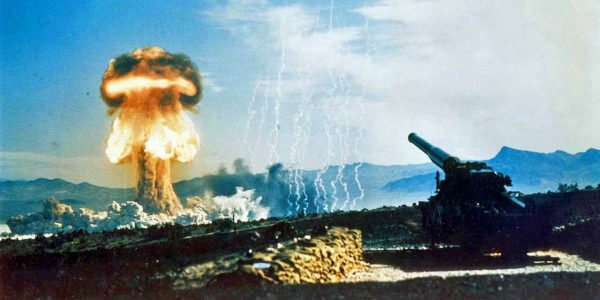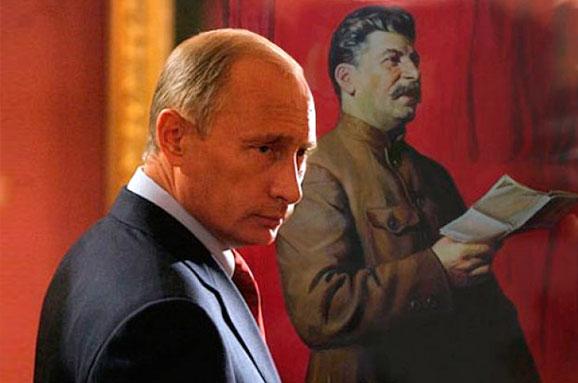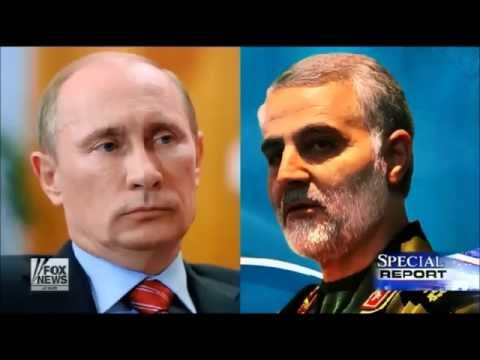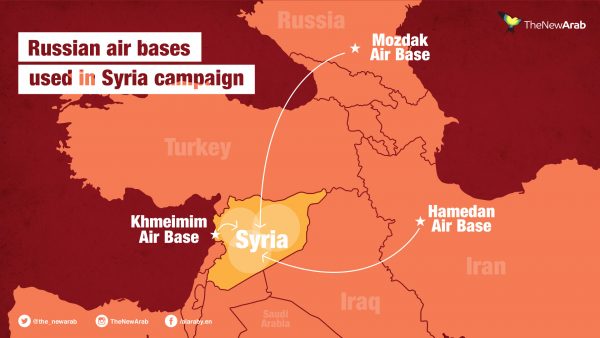
BY
Russia, surrounded by enemies, is readying to fight an epic war for survival. At least that’s what Vladimir Putin wants his countrymen to think. Nearly every evening, Russian state-controlled television leads news broadcasts with video of Russian planes in action over Syria, interspersed with images of NATO tanks and troops menacing Russia’s borders. On 60 Minut, Russia’s top-rated political talk show, analyst Nikita Isayev recently spoke of Russia’s “great victory” in Syria heralding the country’s return to “superpower status.” And in late November, Putin put Russian business on alert: “The ability of our economy to increase military production and services at a given time is one of the most important aspects of military security,” he told a meeting of top military brass in Sochi. “All strategic and simply large-scale enterprise should be ready.”
Like much Russian propaganda, the Kremlin’s claim that the country is at war is based on a kernel of truth. But it’s a very small kernel. In Syria, a single squadron of around 36 Russian combat aircraft serviced by 4,751 personnel based mostly at the Khmeimim airfield has been in action since September 2015. And in eastern Ukraine, Russian regular soldiers in unmarked uniforms have been spotted patrolling alongside rebel irregulars—most recently in the middle of November, when several hundred anonymous troops known as “little green men” showed up in the rebel city of Luhansk to prevent a bloody power struggle between separatist leaders who broke away from Kiev in the summer of 2014.
With Russia’s actual military engagements so small, why is Putin building up the idea that his country is on the verge of a cataclysmic conflict that will require full-scale mobilization of all Russia’s resources? The most obvious reason is the oldest ruse in the politicians’ book—unite a country behind an imagined external enemy to distract from domestic problems. As Russia’s economy reels under the impact of Western sanctions imposed after Putin’s 2014 annexation of Crimea, creating a myth of perpetual war has become a mainstay of the regime’s survival. “Putin doesn’t have the money to offer a lot to the population—household incomes have been contracting for four years in a row,” says Pavel Felgenhauer, a columnist at the independent Moscow daily Novaya Gazeta. “He will be running his re-election campaign [in 2018] on a national security basis, presenting Russia as a country under siege, under attack.”

But there’s another, more worrying reason for the Kremlin’s belligerent rhetoric—it is convinced war is imminent. As long ago as 2013, even before the conflict in Ukraine, the Russian Defense Ministry’s annual strategic plan, titled “The Defense of Russia,” predicted a serious global or regional conflict involving Russia before 2023. “Senior Russians talk about not if but when there is going to be a major war,” says Andrew Monaghan, of Pembroke College, Oxford, and the NATO Defense College in Rome. “They are already on a war footing and have been on it for a long time.”
Putin’s call for industry to be ready to switch to war production is a return to a decades-old Soviet defense theory that every factory in the motherland should be immediately ready to turn out tanks, bullets and planes. “The Soviet economy and its social system were built on preparation for total war,” says Felgenhauer. “The system made the Soviet economy totally uncompetitive…. If Putin is serious about actually implementing this mobilization, it will bankrupt Russia as it bankrupted the USSR. The idea that you can transform a factory that makes cigarettes into manufacturing bullets is absurd in the modern world.”
Nonetheless, swaths of the Russian economy still depend, directly or indirectly, on state defense spending. And even as the Kremlin’s revenues have plummeted, thanks to falling oil prices and sanctions, Putin has ordered a massive increase in military spending. In 2017, military expenses are set to exceed $65 billion. That’s still a fraction of the $611 billion spent by the U.S., but it represents 3.3 percent of Russia’s gross domestic product. And that’s not counting Kremlin spending on semi-military organizations like the newly formed Russian National Guard—a 330,000-strong force under Putin’s direct command that is funded from the Interior Ministry budget—or subsidies to aerospace and other defense-related contractors.
What concerns many in the U.S. and Europe is how Putin is planning to use Russia’s new warships, submarines, helicopters and Bulava-class missiles. “Russia is engaged in a strange sort of unilateral arms race,” says one former British ambassador to Russia, who did not wish to be quoted on the record, as he now has a different brief. “Historically, every previous arms race has ended in war. Except in Russia’s case, nobody is quite sure who they are preparing to fight and where.”
The Middle East is the obvious theater where Russia has been stepping up its presence over the past three years. In recent images from the Syrian town of Deir Ezzor, Russian state television proudly showed the Russian flag flying alongside the Syrian one as government forces loyal to President Bashar al-Assad liberated the city from the Islamic State militant group (ISIS). But the telling part of the picture was the other two flags that also flew on the newly liberated government building—those of Iran and Hezbollah. In deciding to prop up the Assad regime in September 2015, Putin effectively chose to take the side of Iran in the region’s spiraling Sunni-Shiite fight.

Iranian Major-General Qasem Soleimani—the leader of Iranian Quds force troops fighting in Syria and the organizer of anti-American Shiite militias in Iraq who killed over 500 U.S. soldiers during the insurgency from 2003 to 2015—has visited Moscow at least three times since July 2015 to coordinate Russia’s air and special forces support for Assad and Iranian troops on the ground. That alliance pits Russia against the United States in any future regional war between Iran and Saudi Arabia, with whom U.S. President Donald Trump has promised even closer ties.
The most likely scenario for a clash, says Monaghan, is that Moscow and Washington find themselves on opposite sides of a regional conflict that “creates a wider conflagration—for instance, North Korea, or Iran vs. Saudi.”
Having scored an easy strategic victory in Syria, the temptation for Russia to get involved in another conflict is great. “Russia spent a tiny fraction of the blood and treasure that the U.S. and its allies invested in Iraq,” says one senior British security official not authorized to speak on the record. “And they got enormous diplomatic capital out of it. They get to claim their intervention as a great victory, that they’re now back as a force to be reckoned with [in the Middle East]. So of course they’ll want to try to repeat the trick somewhere else…. Everyone loves a short, victorious war.”
The Hot Cold War
Russia’s interest in Syria goes much beyond simply propping up Assad. Back in 2013, the Russian Defense Ministry called for a full-scale naval presence in the Mediterranean. Since 2015, Moscow has greatly expanded a tiny Russian naval base at Tartus, Syria, left over from the Cold War, as well as the nearby major coastal air base at Khmeimim, which gives Russian aircraft coverage of much of the southeastern Mediterranean. Moscow has also gone out of its way to demonstrate the power of its hardware to all players in the region by using deliberately elaborate means to hit targets in Syria. Last year, the Russian navy hit rebel targets north of Aleppo by firing cruise missiles from gunboats in the Caspian Sea, flying them more than 900 miles over Iran and Iraq. And in November, Russia used long-range Tu-22M3 Backfire bombers to hit ISIS in Deir Ezzor—flying them not out of Khmeimim but from Mozdok, west of Chechnya in the Russian North Caucasus.

For Putin, “the Syrian engagement is part of global standoff with the U.S.,” says Felgenhauer. And part of that fight consists of courting former Western allies all over the world with promises of money, gas and arms. In November, Russia signed a deal with Egypt to allow its military jets to use Egyptian airspace and bases, undermining a decades-long friendship with the U.S. that saw Cairo receive over $70 billion in U.S. aid from 1973 to 2013, when President Barack Obama suspended the program after a military coup. Last year, Egyptian President Abdel Fattah el-Sissi visited Moscow and agreed to buy $3.5 billion in jets, helicopters and missiles. The two countries have held joint anti-terrorism drills, and Egypt has signed up to buy Russian-built nuclear power stations. More dangerously, both Putin and el-Sissi are backing Libyan warlord General Khalifa Hifter’s insurgency against the Western-backed government in Tripoli—with a small Russian force stationed in Egypt’s western desert to back the general, according to U.S. military sources quoted by The New York Times.
And then there’s Turkey. In September, Russia made a deal to sell $2 billion worth of advanced missiles to the NATO member, whose old alliance with the U.S. has crumbled over President Recep Tayyip Erdogan’s rollback of democracy and U.S. backing of Kurds in Syria. In October, despite Russia’s new closeness to Iran, Moscow decided to play both sides by also selling U.S. ally Saudi Arabia $3 billion worth of missiles to defend against rocket attacks by Houthi rebels in Yemen.
With more firepower deployed along and outside Russia’s borders than at any time since the collapse of the Soviet Union, an accidental confrontation is a real possibility. In late November, Russian warplanes buzzed a U.S. Poseidon anti-submarine aircraft 6 miles off the coast of Crimea, which is recognized as Russian territory only by Russia and seven other states. “The Russian military have been given orders to shoot down U.S. planes if they stray into Russian offshore airspace around Crimea,” says Felgenhauer. “The local [Russian] commander said that the U.S. pilot was lucky to be alive.” Baltic countries have been reporting a steady escalation of aggressive Russian infractions of their airspace and other dangerous incidents. The most recent was last June, when a Russian aircraft was scrambled to harass a Swedish spy plane over international waters and flew within 6 feet of the jet before backing off.
U.S.-Russian relations are at their lowest point since the Cold War, making the risks of even a small incident escalating into conflict dangerously high. Trump, taking flak for his team’s ties to Russian interference in the 2016 U.S. presidential election, has little incentive to be soft on Russia. And at the same time, Putin has been promoting a narrative that portrays Russia as the victim of U.S. aggression. This is being reinforced daily on Russian state TV with stories on U.S. support for anti-Russian “fascists” in Ukraine and the U.S.’s alleged support for ISIS in Syria. Even Russia’s schoolchildren are being enlisted in the effort to cast Russia as a brave defender of weak nations against U.S. bullying. A recent internet video popular in Russia featured children as young as 10 dressed in military uniform and standing in front of the statue of Mother Russia on the battlefield of Stalingrad, singing: “We are tired of the hegemony of America…. We are ready to follow you into the fight, Uncle Vladimir [Putin].”
Some members of the Russian establishment are alarmed at the military’s takeover of Russia’s foreign policy and propaganda machine. In November, Sergei Rogov, head of an influential Kremlin-funded think tank called the Institute for the U.S. and Canadian Studies, warned that something must be done to avoid the danger of an accidental war. Though Rogov blamed the Europeans and Americans for provoking the situation, he cautioned that “this situation could bring war at any time.” It’s no empty warning. The more Putin’s popularity depends on keeping Russia forever at war, the more dangerous he becomes.
NEWSWEEK
Leave a Reply
You must be logged in to post a comment.